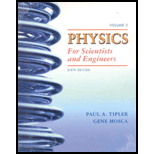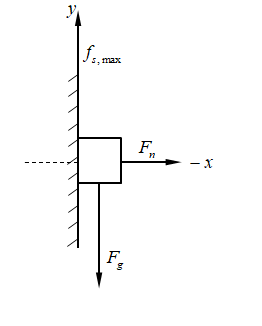
Concept explainers
(a)
The minimum acceleration so that box will not fall to the ground.
(a)
Explanation of Solution
Given:
Mass of box is
Coefficient of friction between the box and the wall is
Formula used:
Draw free body diagram of the box.

Write expression for net force in x -direction.
Here,
Substitute
Here,
Write expression for net force in y -direction.
Substitute
Here,
Here,
Substitute
Here,
Substitute
Solve above expression for
Calculation:
Substitute
Conclusion:
Thus, the minimum acceleration is
(b)
The magnitude of frictional force.
(b)
Explanation of Solution
Given:
Mass of box is
Coefficient of friction between the box and the wall is
Formula used:
Draw free body diagram of the box.

Write expression for net force in y -direction.
Substitute
Here,
Rearrange above expression for
Calculation:
Substitute
Conclusion:
Thus, the magnitude of frictional force is
(c)
The
(c)
Explanation of Solution
Given:
Mass of box is
Coefficient of friction between the box and the wall is
Formula used:
Draw free body diagram of the box.

Write expression for net force in y -direction.
Substitute
Here,
Rearrange above expression for
Calculation:
Substitute
Conclusion:
The friction force is independent of minimum acceleration. Thus, the magnitude of frictional force is
(d)
To show that the box will not fall if the acceleration is greater or equal to
(d)
Explanation of Solution
Given:
Mass of box is
Coefficient of friction between the box and the wall is
Introduction:
Draw free body diagram of the box.

Write expression for net force in x -direction.
Here,
Write expression for net force in y -direction.
Substitute
Here,
Here,
Substitute
Here,
Substitute
Solve above expression for
The minimum acceleration required for the box to not fall in the ground is
If the acceleration is greater than
Conclusion:
Thus, the box will not fall if the acceleration is greater or equal to
Want to see more full solutions like this?
Chapter 5 Solutions
Physics for Scientists and Engineers, Vol. 3
- Consider Figure 5.28. The driver attempts to get the car out of the mud by exerting a perpendicular force of 610.0 N, and the distance she pushes in the middle of the rope is 1.00 m while she stands 6.00 m away from the car on the left and 6.00 m away from the tree on the right. What is the tension Tin the rope, and how do you find the answer?arrow_forwardSuppose a box of mass m = 5 kg is kicked and given an initial velocity of 4.0 m/s to the right. The box slides along and is brought to rest by friction. What is its total displacement, assuming the coefficient of kinetic friction is 0.60?arrow_forwardConsider Figure 5.28. The driver attempts to get the car out of the mud by exerting a perpendicular force of 610.0 N, and the distance she pushes in the middle of the rope is 1.00 m while she stands 6.00 m away from the car on the left and 6.00 m away from the tree on the right. What is the tension T in the rope, and how do you find the answer?arrow_forward
- In which of the following situations do the forces on the body sum to zero?arrow_forwardA uniform push of 150 N, applied at an angle of 30 deg to a 20 kg block which rests on a horizontal surface, gives the block a velocity of 6.5 m/s in 4 s. Find the coefficient of kinetic friction.arrow_forwardIn a pickup game of dorm shuffleboard, students crazed by final exams use a broom to propel a calculus book along the dorm hallway. If the 3.5 kg book is pushed from rest through a distance of 0.90 m by the horizontal 25 N force from the broom and then has a speed of 1.60 m/s, what is the coefficient of kinetic friction between the book and floor?arrow_forward
- If The Net Force Acting On A Body Be Zero, Then Will The Body Remain Necessarily In Rest Position?arrow_forwardThe 300-N block in the figure is at rest on the roughhorizontal plane before the force P is applied at t=0.The magnitude of P is 80t N, where t is the time inseconds, and its direction is constant. The coefficientsof static and kinetic friction are Ms = 0.40 and Mk0.20, respectively. Which of the following most nearlygives the time when the block starts to slide? Which of the following most nearly gives the value of× if the power developed by the force at a giveninstant is 0.20 hp?arrow_forwardWhile the aircraft weighs 5000 kg, accelerates and moves, leaving a load of 150 kg, instantaneous speed, altitude, net engine thrust, wind speed are given. Calculating the distance with the aircraft while the load falls to the ground in a negligible condition of air friction.arrow_forward
- A 2.50 kg mass is released from rest while on and incline of 54.7 degrees. If the coefficient of kinetic friction is 0.529, what is the magnitude of the acceleration of the mass?arrow_forwardA barge is pulled by two tugboats. If the resultant force exerted by the tugboats is 5kN force directed along the x-axis of the barge, determine the tensions in each of the rope knowing that a=45 degrees.arrow_forwardWith the coefficient of static friction between the floor of a truck and a box resting on given, if the truck has an initial velocity of Vi , what is the least distance in which the truck can stop if the box is never to slide?arrow_forward
 University Physics Volume 1PhysicsISBN:9781938168277Author:William Moebs, Samuel J. Ling, Jeff SannyPublisher:OpenStax - Rice University
University Physics Volume 1PhysicsISBN:9781938168277Author:William Moebs, Samuel J. Ling, Jeff SannyPublisher:OpenStax - Rice University
